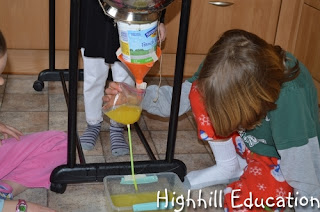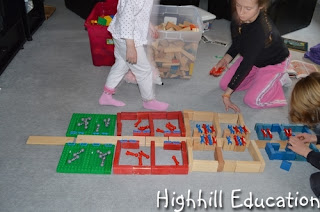Did you know that knitting and math have a lot in common? Estimating, measuring....... and PATTERNS! It recently dawned on me why I love knitting. I love patterns.
That’s what knitting is.
Knitting is really very simple. There are six basic steps
to learn. Casting on and casting off get a project started and finished. Increasing and decreasing are techniques used to add shape to the designs. Knit
stitch and purl stitch are what’s done in between. Many patterns are created
with various combinations of these two simple stitches and a bit of increasing and decreasing.
Here are some examples of patterns created with knitting and purling.
These leg warmers were knit in the round. At the base the pattern was knit one stitch, purl one stitch. The main portion of the leg warmers were plain knitting stitches. The top portion was also plain knitting stitches with a fancy yarn.
This hat was knit in the round. The pattern was knit 10 rows then purl one row (light pink). Then decrease stitches were used at the top to close the hat. (All you do to decrease is knit two stitches together.) The decreasing portion was another pattern. The first round was knit 9, knit 2 together. The second round was knit 8, knit 2 together....... and so on until there were only 4 stitches.
This Kindle case was a simple knitted rectangle much like a scarf. The pattern consisted of knitting stitches with a few purl stitches to create the diamonds.
----- It went knit four, purl one, knit eight, purl one, knit four for the bottom row, then knit three, purl one, knit two, purl one, knit six, purl one, knit two, purl one, knit six, purl one, knit two, purl one, knit three. ----- In each row the increments between the knitting and purling stitches changed. Although it looks complicated, it is nothing but knitting and purling. No increasing or decreasing required. Plus another fun pattern to work with.
Seed Stitch and Ribbing – The ribbing at the base of the leg warmers and the seed stitch at the left side of this photo were both created by knitting one stitch then purling one stitch. The difference is that in ribbing
the stitches are lined up and in seed stitch they are staggered.
To go from creating patterns using various combinations of knit and purl stitches to including cables is easier than it looks. The trick is the a cable needle. It is used to change the order of the
stitches. Cables seem to jump out from the project. Often when creating a
cable the entire row is knitted. Then in the location that the cable is
desired two stitches are placed on the cable needle so that stitches
behind them in line can be knit first. Holding the cable behind the knitting will make the cables twist to the right and holding the cable needle in front of the knitting will make the cables twist to the left. Repeating the use of the cable
needle over the course of several rows makes the cable appear.
The base of this sweater contains a pattern of knit two, purl two ribbing. In the body of the sweater the pattern is
knit ten, purl two, knit two, purl two, knit two, purl two, knit ten for many of the rows and
knit ten, purl two, (knit two, purl two, knit two) - change the order of these stitches using the cable needle - instead of what's in parenthesis put the first two stitches on a cable needle and hold them in the back, (purl one, knit two, knit the two on the cable needle, purl one), purl two, knit ten. Pretty cool huh?
Well if all that is a bit confusing fair isle is another pattern technique that doesn't involve the cable needle and all of the stitches are knit. In fair isle the patterns are created using two
different colors per row. Almost all of the stitches are plain knitting
stitches on the front side and plain purling stitches on the back side. Here are some patterns that can be created using fair isle techniques.

Two balls of yarn were attached to this knitting project where the two colors were desired. Instead of knitting with one color the two balls of yarn were alternated. The pattern was knit two white, knit two purple.
There were different patterns required for each row of the fair isle hat and mittens, but all the stitches were knit stitches. The first row using black at the bottom of the hat was a fun row because it was knit one black, knit one pink.
These mittens contain many different colors, but each row only contains two colors of yarn. Again all the stitches were plain knitting stitches. For the bottom red and green row the pattern was knit one green, knit one red. For the middle row it was knit two green, knit one red.
Fair isle and cable knitting are fun because they are all about patterns. Plus the designs are interesting to create. If you have the basics down I highly recommend trying out these techniques.
There you have it...... Math and knitting are forever linked.
 This post is linked to:
Horrific Knits
Pin Me Linky
Yarn Along
This post is linked to:
Horrific Knits
Pin Me Linky
Yarn Along




































_wm.JPG)





_wm.JPG)
